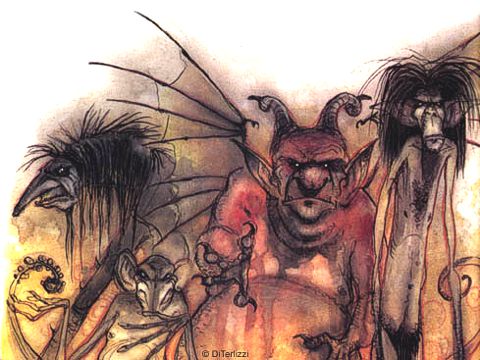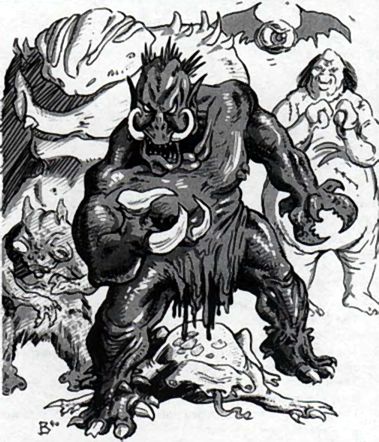

MC Outer Planes Appendix • MC Planescape Appendix I

| Climate/Terrain: | Gray Waste (also Abyss, Carceri and Pandemonium) |
|---|---|
| Frequency: | Common (Gray Waste), Uncommon (Abyss, Carceri, Pandemonium), Very rare (Prime) |
| Organization: | Solitary |
| Activity Cycle: | Any |
| Diet: | Carnivore |
| Intelligence: | Semi- to average (2-10) |
| Treasure: | Nil |
| Alignment: | Neutral evil |
| No. Appearing: | 1-6 (Prime 1) |
| Armor Class: | 3, 2, 1, or 0 |
| Movement: | 6, 9, 12, or 15 (D with wings) |
| Hit Dice: | 6+3, 7+2, 8+1, or 9 |
| THAC0: | 6+3 HD: 15 7+2 and 8+1 HD: 13 9 HD: 11 |
| No. of Attacks: | By hordling type |
| Damage/Attack: | See below |
| Special Attacks: | See below |
| Special Defenses: | See below |
| Magic Resistance: | 6+3 HD: 0% , 7+2 HD: 5%, 8+1 HD: 15% , 9 HD: 30% |
| Size: | S, M, or L |
| Morale: | Unsteady (5-7) |
| XP Value: | Varies by hordling |
Hordlings are the uncounted hordes of the Gray Wastes. They form the majority of the population of that plane. They vary widely in size and appearance. Some are large, some small; some humanoid, some animal-like, some amorphous; some have wings or tentacles. No two look exactly alike, and they have no standard means of communication.
Combat: Choose each hordling’s characteristics as the situation requires. These tables present traits that pertain to combat and flight. Other tables (below) give the appearance of individual hordlings. Choose AC, movement rate, Hit Dice, magic resistance, and size from this table, or roll ld4 for each characteristic:
| Roll | AC | MV | HD | MR | SZ |
|---|---|---|---|---|---|
| 1 | 3 | 6 | 6+3 | 0 | S |
| 2 | 2 | 9 | 7+2 | 5% | M |
| 3 | 1 | 12 | 8+1 | 15% | L |
| 1 | 0 | 15 | 9 | 30% | H |
Choose physical attributes as desired; the lists below suggest typical attributes. Some attributes enhance combat ability, and are labeled with a parenthetical lower case letter, further explained in the Combat section.
| Arms 1 (1), 2 (2-5), 4 (6) | |
|---|---|
| 1 | multi-jointed |
| 2 | telescoping (doubled reach) |
| 3 | short, thick |
| 4 | long, thin |
| 5 | trunk-like |
| 6 | tentacles |
| Legs 2 (1-4), 3 (5), 4 (6) | |
|---|---|
| 1 | long, thin |
| 2 | short, bowed |
| 3 | short, massive |
| 4 | springing (20' range) |
| 5 | hopping (10’ in any direction) |
| 6 | telescoping (can add 50% height) |
| Hands/extremities | |
|---|---|
| 1 | large, thick-fingered (g) |
| 2 | clawed (h) |
| 3 | taloned (i) |
| 4 | pincered (j) |
| 5 | barbed (k) |
| 6 | knobbed(1) |
| Feet/extremities | |
|---|---|
| 1 | prehensile toes, long |
| 2 | full hoofed (m) |
| 3 | splayed hoofed (n) |
| 4 | clawed (0) |
| 5 | suckered |
| 6 | full webbed (swim at normal speed) |
| Back | ||
|---|---|---|
| 1 | humped | |
| 2 | hunched | |
| 3 | knobbed mane | |
| 4 | bristle-maned | |
| 5 | fan-winged (fly 18, max ground speed 9) | |
| 6 | bat-winged (fly 12, max ground speed 12) | |
| Tail | |
|---|---|
| 1 | long, prehensile |
| 2 | short |
| 3 | long |
| 4 | long, clubbed (j) |
| 5 | long, barbed (k) |
| 6 | none |
Hordlings with hands, tentacles, or prehensile toes or tail can use weapons.
| Mouth [ large (1-4), huge (5-6) ] | |
|---|---|
| 1 | protruding tusks (a) |
| 2 | many small fangs (b) |
| 3 | long canines (c) |
| 4 | small tusks (d) |
| 5 | crushing teeth (e) |
| 6 | saw-toothed (f) |
| Strength | |
|---|---|
| 1 | 17 (+1/+1) |
| 2 | 18 (+1/+2) |
| 3 | 18/50 (+1/+3) |
| 4 | 18/75 (+2/+3) |
| 5 | 18/00 (+3/+6) |
| 6 | 19 (+3/+7) |
Having created a hordling, assign its attacks according to its mouth, arm, tail, and leg attributes. The following table provides examples.
| Attack Table – Damage | ||
|---|---|---|
| a | tusks | small 1d4 ; large 2d4 ; huge 2d6 |
| b | fangs | small 1d6 ; large 1d8 |
| c | long canines | large 1d6 ; huge 1d8 |
| d | small tusks | large 1d8 ; huge 1d10 |
| e | crushing teeth | large 1d4+2 ; huge 1d4+3 |
| f | saw-toothed | large 1d3 (1d4 / round thereafter); huge 1d4 (1d6 / round thereafter) |
| g | blow | one hit 1d4 + strength; two hits strangle for 2d4 + strength |
| h | claw | 1d4+1 |
| i | talon | 1d6 |
| j | pincer | 1d4 |
| k | barb | 1 / rd and stuck fast (Strength check to escape) |
| l | knob or club tail | 1d3 |
| m | full hoof | 1d2 |
| n | splayed hoof | 1d3 |
For example, a hordling with two claws, crushing teeth, and a strength of 18/00 would attack at +3 and do 2-5+6/2-5+6/3-6+6.
A hordling may also have special attacks (10%, chance) or defenses (20% chance). These tables list the abilities; roll randomly or choose:
| Special Attacks Table | |
|---|---|
| 1 | Breath works as a small stinking cloud vs. one opponent in a 3’ range. |
| 2 | Gaze works as a ray of enfeeblement vs. one opponent in a 5’ range. |
| 3 | Legs can trip one opponent in melee as a trip spell. |
| 4 | Sound emanation works as a fumble spell against one opponent in a 5' range. |
| 5 | Double attacks for 1 round once per turn. |
| 6 | Acidic spittle missile once per turn (10' range, 2d4 damage) |
| Special Defenses Table | |
|---|---|
| 1 | Hit only by +2 or better magical weapons. |
| 2 | Immune to fire and acid attacks. |
| 3 | Immune to cold, gas, and poison attacks. |
| 4 | Immune to electrical and magic missile attacks. |
| 5 | Unaffected by illusions and mental attacks (charm, etc.). |
| 6 | Regenerates 1d4+1 hp per turn. |
Hordlings have infravision to 120’. Treat hordlings as having 5 Hit Dice for purposes of clerical turning of undead.
Habitat/Society: There are an infinite number of hordlings on the infinite layers of the Abyss. They have no purpose or organization.
Hordlings are petty and vile. They roam the Gray Waste, attacking those weaker than themselves. They sometimes serve under strong leaders, but few leaders maintain hordlings for long, for they are unruly, untrustworthy, and chaotic.
Occasionally, evil mages summon hordlings to do their bidding. Normal summonings always produce a single hordling. The only known way to summon more than a single hordling into the Prime Material Plane is the Bringer of doom, a strange device created by arcane magic during the Age of Doom.
Ecology: Hordlings devour whatever they destroy, usually other hordlings. That there is otherwise no readily available food supply on the Lower Planes makes the endless, relatively weak hordlings common prey for more powerful beings.
The physical appearance of a hordling may become important in play. The following list offers typical features, but many others are possible.
| Color | Head | Head Adornment | Neck | ||||
|---|---|---|---|---|---|---|---|
| 1 | black-brown | 1 | wedge-shaped | 1 | bald | 1 | thick |
| 2 | russet-red | 2 | conical | 2 | mane | 2 | thin |
| 3 | orange-yellow | 4 | discoid | 3 | frills | 3 | long |
| 4 | olive-green | 4 | spherical | 4 | lumps | 4 | thrust forward |
| 5 | blue-purple | 5 | cubical | 5 | spikes (2-8) | 5 | snaky |
| 6 | gray-white | 6 | ovoid | 6 | horns (1-4) | 6 | none apparent |
| Nose | Ears | Overall Visage | |||
|---|---|---|---|---|---|
| 1 | wide, protruding | 1 | large, pointed | 1 | gibbering, drooling |
| 2 | slits only | 2 | small, pointed | 2 | glaring, menacing |
| 3 | hanging snout | 3 | drooping | 3 | twitching, crawling |
| 4 | long, pointed | 4 | large, fanlike | 4 | wrinkled, seamed |
| 5 | large, many warts | 5 | huge, humaniod | 5 | hanging, flaccid |
| 6 | beaked | 6 | none | 6 | rotting, tattered |

